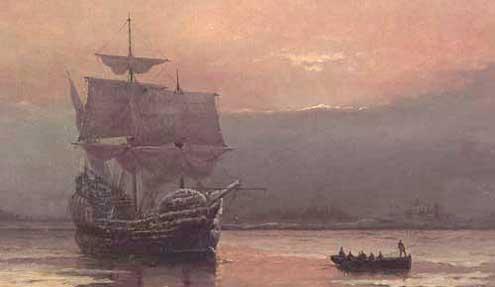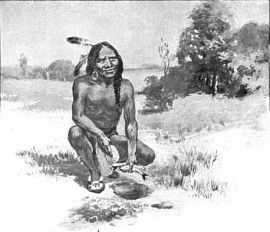
That's not exactly how it happened though. Most of the information Cracked.com cites comes from 1491: New Revelations of the Americas Before Columbus, a book by Charles Mann, and written records from early colonial times, though they don't give any actual citations for those.
"Rather than the thick, unbroken, monumental snarl of trees imagined by Thoreau, the great eastern forest was an ecological kaleidoscope of garden plots, blackberry rambles, pine barrens, and spacious groves of chestnut, hickory, and oak. The first Europeans in Ohio found woodlands that resembled English parks - they could drive carriages through the trees," Mann wrote in 1491.
"Our schoolbooks present the story of the Pilgrims as a heroic myth... referring to 'the little party' in their 'small, storm-battered English vessel,'" says James W. Loewen in a piece titled "The Truth About the First Thanksgiving." He says "the imagery is right out of Star Trek: 'to go boldly where none dared go before.'" Except we've covered that many had gone before when we talked about the myth that Columbus discovered America.
In fact, the pilgrims chose to land in Plymouth because of its cleared fields that had recently been planted in corn, as if by some miracle. As Loewen says, "It was a lovely site for a town. Indeed, until the plague, it had been a town." If you want to read more about the plague, go back to our discussion of myth number six. "Throughout New England, colonists appropriated Indian cornfields, which explains why so many town names - Marshfield, Springfield, Deerfield - end in "field"
And the pilgrims certainly didn't go it alone, they couldn't have. They arrived in winter, and according to Loewen weren't prepared. Because the villages had been emptied by the plague the pilgrims were able to pillage what they needed. Loewen included this graph from a colonist's journal in his piece about the first Thanksgiving:
We marched to the place we called Cornhill, where we had found the corn before. At another place we had seen before, we dug and found some more corn, two or three baskets full, and a bag of beans... In all we had about ten bushels, which will be enough for seed. It was with God's help that we found this corn, for how else could we have done it, without meeting some Indians who might trouble us... The next morning, we found a place like a grave. We decided to dig it up. We found first a mat, and under that a fine bow... We also found bowls, trays, dishes, and things like that. We took several of the prettiest things to carry away with us, and covered the body up again.
Squanto helped the pilgrims at Plymouth after finding his tribe had been decimated by the plague.
One of the living Indians who helped the pilgrims, and whose story tends to be misrepresented in history books, is Squanto. Cracked.com described his "epic journey" as one that puts Homer's Odyssey to shame, and they'd be right. He was a member of the Patuxet band of the Wampanoag tribe, and one of 20 captured by English explorer Thomas Hunt in 1614. And that wasn't the first time he'd been kidnapped. According to Loewen, he and four Penobscot Indians had been taken by a British captain in about 1605 to England, where Squanto spend nine years. By the time he made it home to Massachusetts he was barely there a year before he was taken by Hunt.
Squanto was sold into slavery in Malaga, Spain, escaped and had by then learned enough English to talk a ship captain into taking him back to Cape Cod in 1619. But sadly, this time when he returned home, he was the only one left. His tribe had been decimated by the plague two years before his return. So, when the pilgrims showed up he decided to help them learn to live in his village.
Not only did the white settlers not settle anything, they didn't carve anything out of the untamed wilderness. Seems like they were just in the right place at the right time. The plague the Europeans brought with them did most of the work for them by greatly reducing the number of Native Americans already living here, and the Europeans then just moved into towns the Indians had already set up.
Missed a Myth:
American History Myths Debunked: No Native Influence on Founding Fathers
American History Myths Debunked: Columbus Discovered America
American History Myths Debunked: The Indians Weren't Defeated by White Settlers
American History Myths Debunked: Columbus Might Have Been Jewish - And Other Unknown Facts
American History Myths Debunked: Europeans Brought Culture to North America




In fact, the pilgrims chose to land in Plymouth because of its cleared fields that had recently been planted in corn, as if by some miracle. As Loewen says, "It was a lovely site for a town. Indeed, until the plague, it had been a town." If you want to read more about the plague, go back to our discussion of myth number six. "Throughout New England, colonists appropriated Indian cornfields, which explains why so many town names - Marshfield, Springfield, Deerfield - end in "field"
And the pilgrims certainly didn't go it alone, they couldn't have. They arrived in winter, and according to Loewen weren't prepared. Because the villages had been emptied by the plague the pilgrims were able to pillage what they needed. Loewen included this graph from a colonist's journal in his piece about the first Thanksgiving :
Which was it, fields recently been planted in corn, or they arrived in winter? You cannot have it both ways.
Regarding the first Thanksgiving, I go into it in great detail here: [Link]